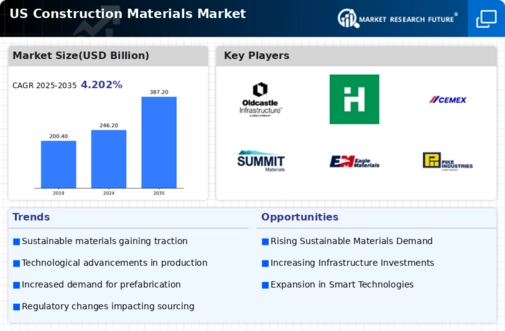Rising Infrastructure Investments
The construction materials-testing-equipment market is experiencing a notable boost due to increased investments in infrastructure across the United States. Government initiatives aimed at enhancing transportation networks, bridges, and public facilities are driving demand for reliable testing equipment. In 2025, federal and state budgets allocated approximately $1 trillion for infrastructure projects, which is expected to create a substantial market for testing equipment. This surge in funding emphasizes the necessity for quality assurance in construction materials, thereby propelling the growth of the construction materials-testing-equipment market. As projects expand, the need for accurate testing to ensure compliance with safety and performance standards becomes paramount, further solidifying the market's relevance in the construction sector.
Increased Focus on Safety Standards
Safety standards in construction are becoming more stringent, which is influencing the construction materials-testing-equipment market. Regulatory bodies are enforcing higher compliance requirements to ensure the safety and durability of construction materials. In 2025, it is anticipated that compliance with safety regulations will drive a 25% increase in the demand for testing equipment. This heightened focus on safety not only protects workers but also enhances the longevity of structures. As a result, construction firms are compelled to invest in reliable testing solutions to meet these standards, thereby fostering growth within the construction materials-testing-equipment market.
Growing Demand for Quality Assurance
Quality assurance in construction is becoming increasingly critical, leading to a heightened demand for testing equipment in the construction materials-testing-equipment market. As construction projects become more complex, stakeholders are prioritizing the integrity of materials used. In 2025, it is estimated that around 70% of construction firms in the US are implementing stringent quality control measures, which necessitate advanced testing solutions. This trend indicates a shift towards a more quality-centric approach in construction, where the reliability of materials is non-negotiable. Consequently, the construction materials-testing-equipment market is likely to expand as companies seek to invest in sophisticated testing technologies to meet these evolving standards.
Emerging Sustainable Construction Practices
The shift towards sustainable construction practices is reshaping the construction materials-testing-equipment market. As environmental concerns gain prominence, construction companies are increasingly adopting eco-friendly materials and practices. In 2025, it is estimated that the market for sustainable construction materials will grow by 30%, necessitating specialized testing equipment to evaluate these new materials. This trend indicates a growing awareness of the environmental impact of construction, prompting the need for testing solutions that can assess the performance and safety of sustainable materials. Consequently, the construction materials-testing-equipment market is likely to benefit from this transition, as firms seek to ensure compliance with sustainability standards.
Technological Integration in Testing Processes
The integration of advanced technologies into testing processes is transforming the construction materials-testing-equipment market. Innovations such as automation, artificial intelligence, and data analytics are enhancing the efficiency and accuracy of material testing. In 2025, it is projected that approximately 40% of testing equipment will incorporate smart technologies, allowing for real-time data collection and analysis. This technological evolution not only streamlines testing procedures but also reduces human error, thereby improving overall project outcomes. As construction firms increasingly adopt these technologies, the demand for modern testing equipment is expected to rise, positioning the construction materials-testing-equipment market for significant growth.





















Leave a Comment